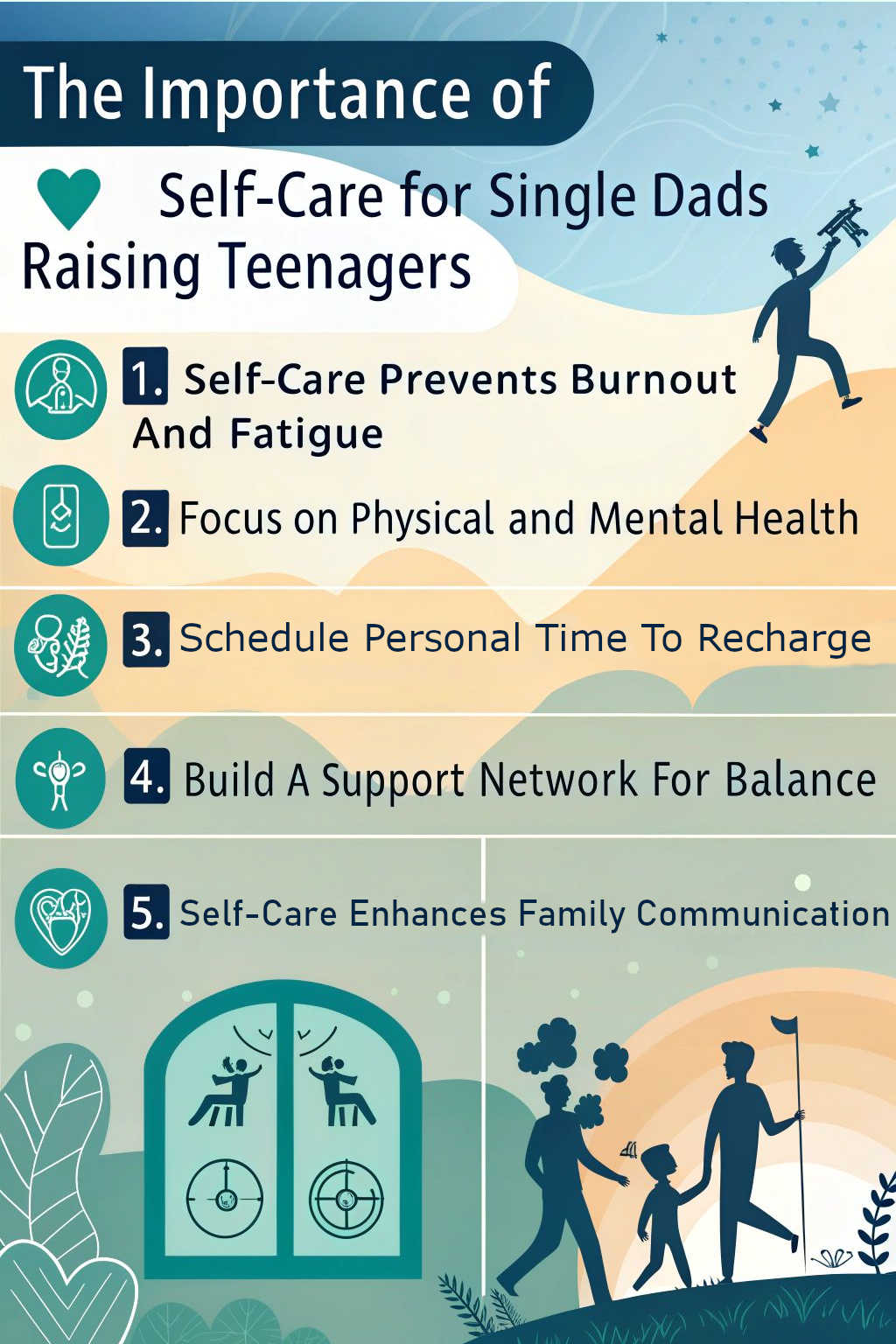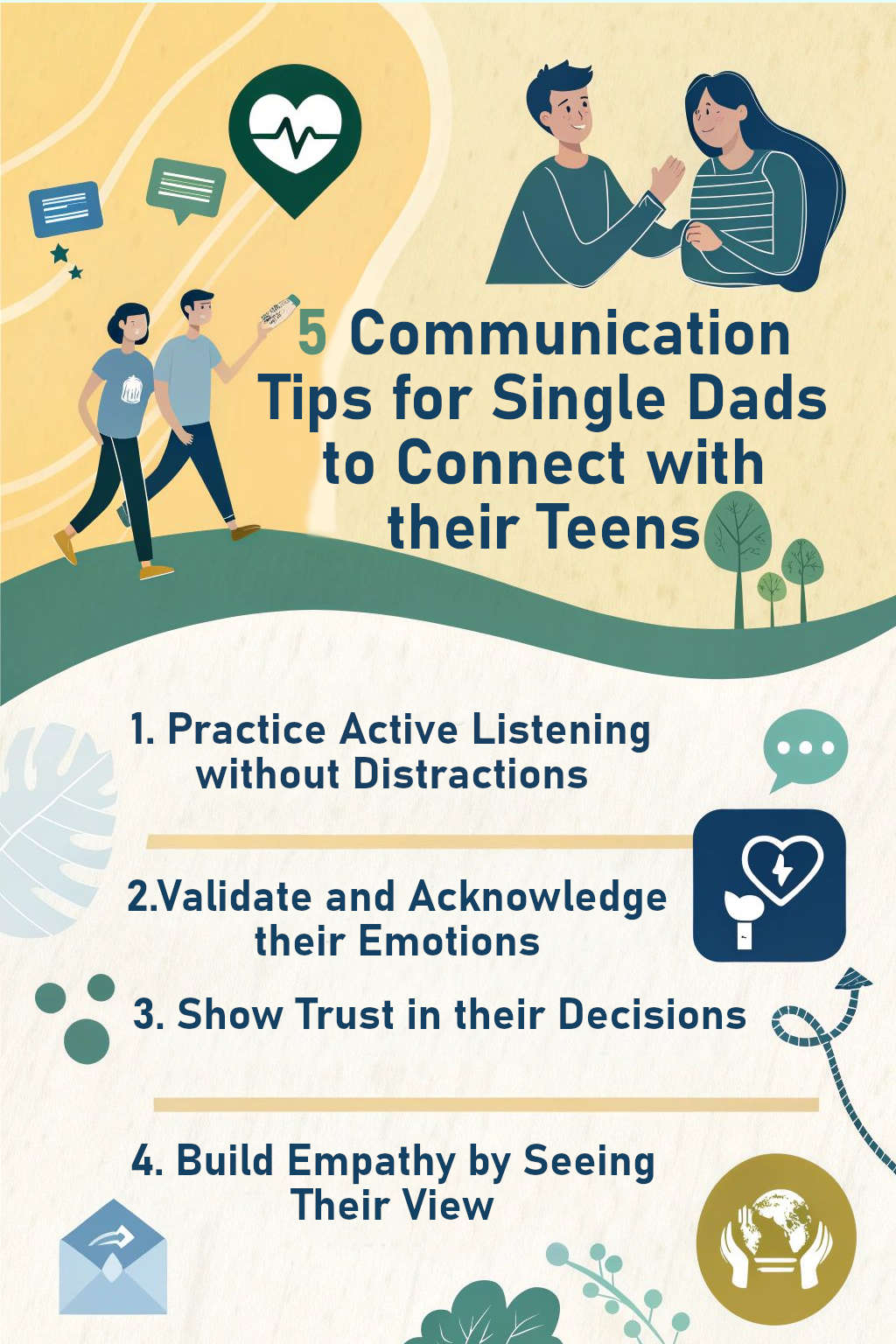The Importance of Self-Care For Single Dads Raising Teenagers
Being a single dad raising teenagers is tough. You juggle work, home, and parenting duties alone. It’s easy to forget about your own needs when you’re so focused on your kids. But taking care of yourself is key to being a good parent.
Studies show that single dads often face higher stress levels than other parents. This can lead to burnout if left unchecked. Self-care isn’t selfish – it’s needed to stay healthy and be there for your teens.
This article will share simple ways for single dads to practice self-care. You’ll learn how to recharge and be your best self. Ready to put yourself first?
Key Takeaways
- Self-care is crucial for single dads raising teens to prevent burnout and stay emotionally resilient.
- Key areas of self-care include physical health (exercise, sleep, nutrition), mental health (stress management, relaxation), and emotional well-being (acknowledging feelings, seeking support).
- Practical self-care strategies involve scheduling personal time, building a support network, setting boundaries, and engaging in hobbies.
- Practicing self-care leads to improved patience, better communication with teens, and enhanced overall quality of life for single dads.
- Dr. Emily Chen, a child psychologist with 20 years of experience, emphasizes that self-care is vital for single dads to recharge and cope with stress, not a selfish act.
Challenges Faced by Single Dads Raising Teenagers
Single dads raising teens face unique hurdles. They juggle work, home life, and their kids’ growing need for freedom.
Emotional demands
Single dads raising teens face big emotional challenges. Teens often have mood swings and need lots of support. This can drain a dad’s energy fast. I’ve seen many dads struggle to keep up with their teen’s changing needs.
It’s tough to stay calm when your kid is upset or angry.
Dads must also deal with their own feelings. They might feel sad, stressed, or lonely as a single parent. Dr. O from TheTeenDoc in San Mateo says self-care is key. Taking time to process emotions helps dads stay strong for their kids.
It’s not selfish – it’s needed to be a good parent.

Balancing work and parenting
Juggling work and parenting is tough for single dads. I’ve been there, trying to meet deadlines while helping with homework. It’s a constant tug-of-war between job duties and family needs.
Time management becomes crucial. I learned to set clear boundaries at work and home. This meant saying no to extra shifts and scheduling quality time with my teen.
Dr. O, a parenting expert, suggests using lunch breaks for quick check-ins with kids. This small act can make a big difference. I started doing this and saw my bond with my daughter grow stronger.
Finding this balance isn’t easy, but it’s worth it. Both your career and your teen benefit when you strike the right chord.
Navigating teen independence
Teenage independence can be tricky for single dads. Teens want more freedom, but they still need guidance. It’s a balancing act. As a single dad, I’ve learned to give my teen space while staying involved.
I set clear rules and talk often with my kid. This helps build trust and keeps them safe.
Self-care isn’t selfish. It’s necessary for single dads to be their best for their teens. – Dr. Adekemi Dr. O Oguntala
Letting go bit by bit is key. I allow my teen to make small choices and learn from mistakes. This builds their confidence and decision-making skills. At the same time, I’m always there for support.
It’s not easy, but seeing my teen grow into a responsible adult is worth it.

Why Self-Care is Essential for Single Dads
Self-care is a must for single dads raising teens. It helps dads stay strong and patient during tough times.
Preventing burnout
Single dads raising teens face a tough job. They often put their kids first and forget about themselves. This can lead to burnout – feeling tired, stressed, and unable to cope. Many dads hit this wall, myself included.
It’s crucial to spot the signs early and take action.
To avoid burnout, dads need to make self-care a priority. This means setting aside time for rest, exercise, and fun activities. It’s not selfish; it’s necessary. Dads who take care of themselves have more energy and patience for their teens.
They’re better equipped to handle the ups and downs of parenting. Taking care of yourself is essential, as you can’t give what you don’t have.
Enhancing emotional resilience
Single dads raising teens need strong emotional resilience. This skill helps them handle stress and bounce back from tough times. Building resilience starts with self-care habits like exercise, good sleep, and healthy eating.
These habits boost mood and energy levels. Dads can also practice mindfulness or meditation to stay calm under pressure. Talking to friends or joining support groups for single parents can provide emotional backup.
Learning to set boundaries and say “no” when needed protects mental health. Resilient dads model healthy coping for their teens, creating a more positive home life.
Strengthening parent-teen relationships
Self-care helps single dads build stronger bonds with their teens. Taking time for yourself lets you recharge and be more present for your kids. This means you can listen better, show more patience, and handle tough talks with a clear head.
Teens need parents who are calm and steady, especially during their rocky teenage years.
Good parent-teen ties also come from shared fun times. Single dads who make space for hobbies and interests can invite their teens to join in. This creates chances to connect over shared likes or to learn from each other.
Whether it’s hiking, cooking, or watching movies, these moments help keep your relationship strong as your teen grows up.
Key Areas of Self-Care for Single Dads
Single dads need to focus on their physical, mental, and emotional health to thrive. Read on to learn about key self-care areas for single fathers raising teens.
Physical health: exercise, sleep, and nutrition
Physical health is key for single dads raising teens. Taking care of your body helps you handle stress and stay energized for parenting.
- Exercise regularly to boost your mood and energy. Aim for 30 minutes of activity most days, even if it’s just a brisk walk.
- Get enough sleep each night, ideally 7-9 hours. A good night’s rest helps you stay patient with your teens.
- Eat a balanced diet with plenty of fruits, veggies, and whole grains. Proper nutrition fuels your body and mind for daily challenges.
- Stay hydrated by drinking water throughout the day. This helps you feel alert and focused.
- Make time for annual check-ups with your doctor. Preventive care keeps you healthy for the long haul.
- Try stress-busting activities like yoga or meditation. These can calm your mind and reduce tension.
- Limit alcohol and avoid smoking. These habits can hurt your health and set a bad example for your kids.
- Get outside for fresh air and sunshine when possible. Nature can lift your spirits and give you a mental break.
- Find physical activities you enjoy doing with your teens. This doubles as bonding time and exercise.
- Prioritize self-care even when you’re busy. Your health matters just as much as your kids’ well-being.
Mental health: stress management and relaxation
Single dads raising teenagers face unique mental health challenges. Stress management and relaxation are key to maintaining a healthy mindset and strong parent-teen bond.
- Take deep breaths daily. This simple act can lower stress hormones and calm your mind in just a few minutes.
- Try meditation apps. Many free options offer guided sessions to help quiet racing thoughts and reduce anxiety.
- Schedule “me time” regularly. Even 15 minutes of alone time doing something you enjoy can recharge your batteries.
- Exercise often. Physical activity releases feel-good chemicals in the brain and helps manage stress levels.
- Connect with other single parents. Sharing experiences with those who understand can provide emotional support.
- Limit screen time, especially before bed. The blue light from devices can disrupt sleep and increase stress.
- Practice gratitude daily. Focusing on the positives, no matter how small, can shift your mindset and mood.
- Learn to say “no” to extra commitments. Overextending yourself leads to burnout and increased stress.
- Try progressive muscle relaxation. This technique involves tensing and relaxing muscle groups to release physical tension.
- Seek professional help if needed. Talking to a therapist can provide coping tools and support for managing stress.
Emotional well-being: acknowledging feelings and seeking support
Emotional well-being is crucial for single dads raising teenagers. Taking care of your feelings and getting help can make a big difference in your life and your teen’s.
- Talk about your feelings with trusted friends or family members. Sharing your thoughts can help you feel less alone and more understood.
- Join a support group for single parents. You’ll meet others who face similar challenges and can offer advice and encouragement.
- Write in a journal to express your emotions. This can help you process your feelings and reduce stress.
- Seek professional help if you’re struggling. A therapist can provide tools to manage stress and improve your mental health.
- Practice self-compassion. Be kind to yourself and remember that it’s okay to make mistakes.
- Set aside time each day for relaxation. Even a few minutes of deep breathing or meditation can help calm your mind.
- Connect with other parents at your teen’s school or activities. Building a network of support can ease the burden of single parenting.
- Learn to recognize and manage your stress triggers. Knowing what affects you can help you avoid or handle tough situations better.
- Celebrate your successes, no matter how small. Acknowledging your achievements boosts your mood and confidence.
- Reach out for help when you need it. Asking for support is a sign of strength, not weakness

Practical Self-Care Strategies
Self-care is vital for single dads raising teens. Try these easy steps to boost your well-being and parent better.
Scheduling time for yourself
As a single dad, carving out time for yourself is key. I’ve found that setting aside even 30 minutes a day for self-care works wonders. This could be early morning before the kids wake up or after they’ve gone to bed.
During this time, I focus on activities that recharge me – reading, exercising, or simply enjoying a quiet cup of coffee. It’s not selfish; it’s necessary for staying balanced and being a better parent.
Making self-care a regular part of your routine takes practice. I started by blocking off time in my calendar, treating it like any other important appointment. Over time, it became a habit.
Now, my kids know and respect this time, which has helped them understand the value of personal space and self-care too. Taking care of yourself isn’t a luxury – it’s essential for single dads raising teens.
Building a support network
Single dads need friends too! Building a support network is key for your well-being. Reach out to other parents at school events or join local single parent groups. These connections can offer a listening ear and shared experiences.
I found great support through my kids’ sports teams, bonding with other dads on the sidelines. Don’t hesitate to ask for help when you need it.
Your network can include family, friends, or even a therapist. Having people to lean on makes the tough days easier. It’s not just about getting help with tasks – emotional support is crucial.
Talking through challenges with others who understand can be a huge relief. Prioritizing your well-being helps you be a better dad to your teens.
Setting boundaries and managing expectations
Single dads need to set clear limits with their teens. This helps both parties know what’s okay and what’s not. I’ve found that talking openly about rules and consequences works well.
It’s key to stick to these boundaries, even when it’s tough. Teens might push back, but they actually feel safer with firm limits in place.
Managing expectations is just as vital. Dads should be real about what they can do. It’s okay to say no sometimes. I’ve learned to explain my choices to my kids. This helps them understand and accept when things don’t go their way.
Being honest about limits builds trust and respect in the long run.
Engaging in hobbies and personal interests
Hobbies and personal interests are vital for single dads. They offer a break from daily stress and help recharge your batteries. I found this out when I started painting again after years of neglect.
It gave me a sense of peace and accomplishment outside of parenting. Try to carve out time each week for activities you enjoy, whether it’s reading, gardening, or playing sports.
Your personal pursuits can also inspire your teens. They see you valuing self-care and following your passions. This sets a great example for them to explore their own interests. Plus, sharing your hobbies with your kids can create special bonding moments.
It’s a win-win for both you and your teenagers.
Benefits of Practicing Self-Care
Self-care helps single dads stay calm and connect better with their teens. Want to learn more about how self-care can change your life as a single dad? Keep reading!
Improved patience and understanding
Self-care helps single dads become more patient with their teens. I’ve seen this firsthand as a counselor for single parents. Taking time to relax and recharge lets dads approach conflicts calmly.
They can listen better and see things from their teen’s point of view. This leads to fewer arguments and more understanding between parent and child.
Dads who practice self-care also set a good example for their kids. Teens learn it’s okay to take care of themselves too. This creates a more peaceful home for everyone. Small acts of self-care, like deep breaths or short walks, can make a big difference in how dads react to stress.
Better communication with teenagers
Self-care helps single dads talk better with their teens. I’ve seen this firsthand as a counselor. Dads who take time for themselves are calmer and more open. They listen more and yell less.
This creates a safe space for teens to share their thoughts and feelings.
Good talks with teens don’t just happen. They need work from both sides. Dads who practice self-care have more energy for these chats. They can stay patient during tough topics. Teens feel this and open up more.
It’s a win-win that makes family life smoother.
Enhanced overall quality of life
Self-care boosts a single dad’s overall life quality. It helps dads feel happier and more balanced. This leads to better relationships with their teens. Dads who take care of themselves have more energy for work and family life.
They can handle stress better and enjoy their time with their kids more.
Healthy dads set good examples for their teens. They show that it’s important to value oneself. This can inspire teens to take care of themselves too. A dad who practices self-care is often calmer and more patient.
This creates a more peaceful home for everyone.

Conclusion
Self-care is key for single dads raising teens. It helps them stay strong and be better parents. Dr. Emily Chen, a child psychologist with 20 years of experience, shares her thoughts on this topic.
Dr. Chen says, “Self-care isn’t selfish. It’s vital for single dads to recharge and cope with stress.” She notes that taking time for oneself can improve patience and communication with teens.
“Safety and ethics are important in self-care,” Dr. Chen adds. “Dads should choose healthy ways to relax and avoid harmful habits.” She suggests talking openly with teens about self-care to set a good example.
For daily life, Dr. Chen recommends simple acts like deep breathing or short walks. “Even small breaks can make a big difference,” she explains. She also advises joining support groups for single parents.
Dr. Chen points out pros and cons of self-care. “It can boost energy and mood, but it takes time and effort,” she states. She urges dads to find what works best for them and their families.
In her final thoughts, Dr. Chen stresses, “Self-care is a must for single dads with teens. It helps them stay calm, focused, and ready to handle challenges.” She believes that by taking care of themselves, dads can create a happier home for everyone
FAQs
1. Why is self-care crucial for single dads with teens?
Self-care helps single dads stay balanced. It’s not selfish – it’s necessary. Taking care of yourself means you can better care for your kids. You’ll have more energy and patience to handle teen challenges.
2. What are some quick self-care tips for busy single dads?
Find small moments for yourself. Take a short walk, read a book, or call a friend. Even five minutes of deep breathing can help. Remember, self-care doesn’t have to be time-consuming or expensive.
3. How can single dads model self-care for their teenagers?
Show your teens that self-care matters. Talk about why you exercise or meditate. Invite them to join you in healthy activities. When they see you prioritizing self-care, they’ll learn its value too.
4. What if single dads feel guilty about taking time for self-care?
Guilt is common, but it’s misplaced. Think of self-care as refueling. You wouldn’t expect your car to run without gas. The same goes for you. Taking care of yourself isn’t a luxury – it’s essential for being a good parent.
Text content













